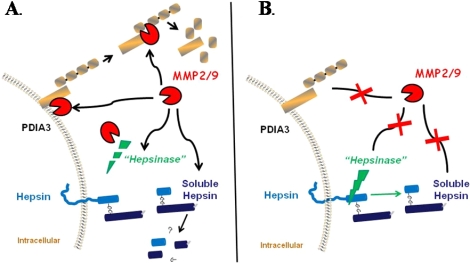FIG. 7.
Schematic representation of gelatinolytic activity in the ovary. MMP2/9 is able to degrade PDIA3 on the cell surface or, once released, it is able to be further degraded in the conditioned media (A). When gelatinolytic activity is inhibited (B), PDIA3 is not degraded, resulting in an increase in PDIA3 on the cell surface and a decrease in PDIA3 in the conditioned media. For hepsin, inhibition of gelatinolytic activity resulted in an increase in the soluble fragment of hepsin in the conditioned media (B). This could occur by one of several mechanisms. The gelatinases could act directly on the soluble hepsin fragment or could act to degrade an intermediary proteinase (i.e., a hepsinase) that regulates the cleavage of hepsin (A). Inhibiting MMP2/9 would block degradation of the 29-kDa fragment or would protect the hepsinase, allowing it to cleave hepsin and release the soluble form of the protein into the conditioned media.

